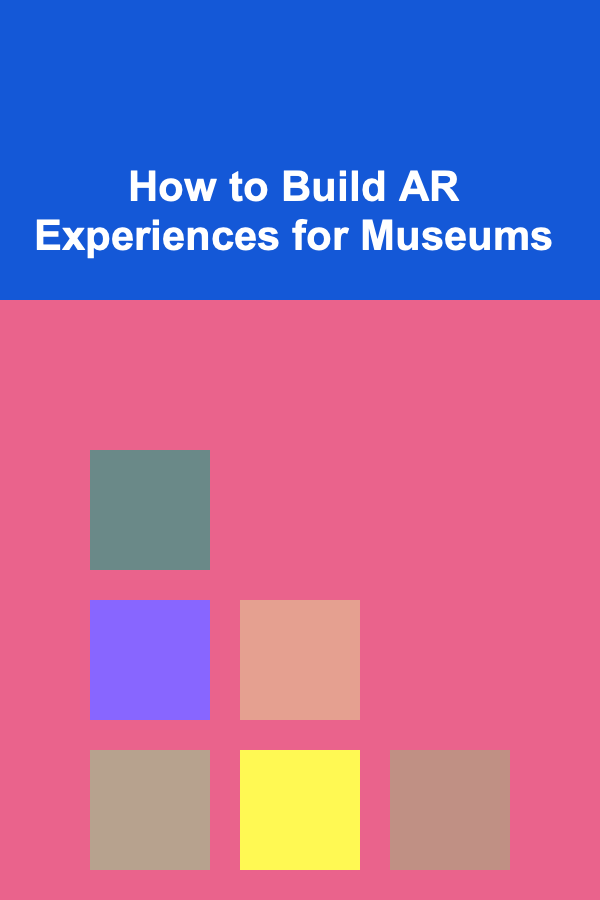
How to Use Technology to Enhance Your Home Staging Process
ebook include PDF & Audio bundle (Micro Guide)
$12.99$5.99
Limited Time Offer! Order within the next:

Home staging has long been recognized as one of the most effective ways to make a property more appealing to potential buyers. It involves styling and arranging furniture, decor, and lighting to showcase a home's best features and downplay its flaws. However, in today's digital age, technology has revolutionized the home staging process, making it more efficient, cost-effective, and impactful. By incorporating modern tools and techniques, real estate professionals and homeowners can elevate the staging process, create more immersive experiences, and ultimately increase the chances of selling a home faster and at a higher price.
This article will explore how various technological tools and strategies can enhance the home staging process, providing practical tips and insights for real estate professionals, interior designers, and homeowners alike.
The Impact of Technology on the Home Staging Industry
Technology has transformed nearly every aspect of our lives, and home staging is no exception. Traditionally, staging a home required the physical relocation of furniture, the purchase of new decor items, and the hiring of professionals to style each room. While this method is still effective, it often comes with significant costs and time commitments.
With the advent of technology, many of these processes can now be streamlined, making home staging more accessible and affordable. Additionally, technology offers new ways to visualize and present homes, improving the buyer's experience and increasing engagement. Through the use of virtual staging, 3D walkthroughs, augmented reality (AR), artificial intelligence (AI), and other digital tools, staging has become more versatile and effective.
Let's break down the key technologies that are reshaping the home staging process.
Virtual Staging: The Game-Changer
One of the most revolutionary innovations in the home staging industry is virtual staging. Virtual staging allows homeowners, real estate agents, and interior designers to digitally furnish and decorate a space without physically moving or purchasing any furniture. It is particularly useful for vacant homes, where potential buyers may struggle to imagine how the space can be used.
How Virtual Staging Works
Virtual staging typically involves taking high-quality photos of a home's rooms and then using specialized software to add virtual furniture, artwork, rugs, and other decorative elements. These items are digitally inserted into the image, creating a realistic, fully staged room that appears as if it were physically staged.
Some of the popular software tools for virtual staging include:
- BoxBrownie: A service that allows you to upload photos of a vacant property and receive digitally staged images within a short time. BoxBrownie offers a range of styles and decor options to suit different property types and buyer preferences.
- Virtual Staging Solutions: Another provider of virtual staging services, offering customization and digital enhancements for photos, including the addition of furniture, decor, and color adjustments.
Benefits of Virtual Staging
- Cost-Effective: Virtual staging is significantly more affordable than traditional staging because it eliminates the need to rent or purchase furniture, hire movers, or spend time setting up physical spaces.
- Quick Turnaround: Virtual staging can be completed in a matter of days, whereas traditional staging can take much longer. This speed is essential in today's fast-moving real estate market.
- Flexibility: Virtual staging allows you to experiment with different design styles and layouts to appeal to a broader range of buyers. If one design doesn't resonate, you can easily try another.
- Appealing for Online Listings: Since most home buyers begin their search online, having virtual staging images for listings can make a property stand out. The digital images are often clearer and more polished than photos of an empty or poorly staged room.
Considerations for Virtual Staging
While virtual staging offers many advantages, it's important to use it ethically. Misleading buyers by digitally enhancing a home's features or hiding flaws can lead to dissatisfaction and mistrust. It is crucial that virtual staging is used to enhance the space in a realistic way, not to misrepresent it. Always make sure to disclose that the images are virtually staged.
3D Walkthroughs and Virtual Tours: Immersive Buyer Experience
Another game-changing technological advancement in home staging is the use of 3D walkthroughs and virtual tours. These technologies allow potential buyers to experience a home in a virtual environment before physically visiting the property. This is particularly helpful for long-distance buyers or those who want to filter through properties before scheduling an in-person tour.
How 3D Walkthroughs Work
3D walkthroughs use a 3D camera or a specialized scanning device to capture the layout and features of a home. The camera takes multiple shots of each room, capturing images from various angles. These images are then stitched together using software to create a 3D model of the home. Buyers can navigate through this model, exploring rooms, virtual staging elements, and even getting a sense of the flow of the space.
Popular platforms that offer 3D walkthroughs include:
- Matterport: A leader in the 3D scanning and virtual tour industry, Matterport creates highly detailed 3D models that allow potential buyers to virtually walk through homes. Matterport's technology is compatible with various devices, including smartphones, tablets, and VR headsets.
- Zillow 3D Home: Zillow offers a 3D home tour feature that provides an interactive, immersive way for buyers to view a property.
Benefits of 3D Walkthroughs and Virtual Tours
- Convenience for Buyers: Potential buyers can explore homes from the comfort of their own homes, eliminating the need for multiple in-person visits. This is particularly advantageous for out-of-town or international buyers.
- Increased Engagement: 3D walkthroughs and virtual tours increase engagement by allowing buyers to get a better feel for the space. They can virtually walk from room to room, inspect details, and even measure dimensions using built-in tools.
- Reduced Time on the Market: Listings with 3D tours often sell faster because they attract more buyers and provide an engaging experience that encourages faster decision-making.
Considerations for 3D Walkthroughs and Virtual Tours
While 3D walkthroughs and virtual tours offer immense value, they are not a substitute for in-person visits. They should be seen as a complement to traditional home staging methods, not a replacement. Additionally, it's important to ensure that the virtual tour accurately represents the property, without over-selling or exaggerating its features.
Augmented Reality (AR) for Interactive Home Staging
Augmented Reality (AR) technology allows users to superimpose digital objects and information onto their physical environment. In the context of home staging, AR can be used to help buyers visualize how different furniture pieces or decor items might look in a space, without physically moving anything.
How AR Works in Home Staging
Using a smartphone or tablet, buyers can point their device's camera at a room and use AR apps to virtually place items like couches, tables, and artwork within the room. Some apps allow users to see the furniture from different angles, adjust the size and color, and even switch out pieces in real-time.
Popular AR apps for home staging include:
- IKEA Place: IKEA's AR app lets users visualize how IKEA furniture would look in their own home by superimposing the digital models of products into their actual living spaces.
- Houzz: Houzz offers a similar AR feature, allowing users to browse through millions of products and see how they would fit in their homes.
Benefits of AR in Home Staging
- Increased Buyer Engagement: AR gives buyers a more interactive experience, which can keep them engaged with the property listing for longer. The ability to visualize changes instantly makes the process more fun and practical.
- Cost-Effective and Flexible: AR can allow homeowners to experiment with different furniture arrangements without the need to move or purchase new items. This is particularly useful in vacant homes where buyers may struggle to visualize how the space can be used.
- Real-Time Visualization: With AR, buyers can see exactly how different design choices will look in the room. This ability to see immediate results enhances their experience and makes them feel more confident in their choices.
Considerations for AR in Home Staging
While AR technology offers exciting possibilities, it requires users to have the right devices (smartphones or tablets) and a stable internet connection. Additionally, AR is a tool for visualization, but it can't replace the physical experience of viewing a home in person.
Artificial Intelligence (AI) and Predictive Analytics in Home Staging
AI and predictive analytics are two powerful technologies that can be leveraged to optimize the home staging process. These technologies use data to predict buyer preferences, recommend design styles, and even determine the ideal price range for a property.
How AI Can Enhance Home Staging
- Predicting Buyer Preferences: AI algorithms can analyze past buyer behavior and preferences to recommend the best furniture styles, color schemes, and design elements for a particular property.
- Optimizing Property Listings: AI-powered platforms can analyze market data and provide insights on how to price a property, when to list it, and how to stage it to attract the most potential buyers.
- Virtual Design Assistance: Some AI-driven platforms can help create virtual staging designs based on buyer preferences, offering personalized staging recommendations.
Benefits of AI in Home Staging
- Tailored Staging Recommendations: By analyzing market trends and buyer behavior, AI can help stagers create spaces that align with current preferences, increasing the likelihood of a quick sale.
- Data-Driven Decisions: AI uses data to make more informed decisions, helping homeowners and agents make better choices about how to stage and market a property.
- Efficiency and Time Savings: AI can automate various aspects of the staging process, such as furniture selection, layout planning, and pricing optimization, reducing the time spent on decision-making.
Considerations for AI in Home Staging
While AI provides valuable insights, it's important to combine technology with human expertise. AI cannot fully replace the creativity and intuition that a professional stager brings to the process. It should be used as a tool to support decision-making, not as a standalone solution.
Conclusion
Technology has had a profound impact on the home staging process, offering new tools and strategies to enhance the way homes are presented to potential buyers. From virtual staging and 3D walkthroughs to augmented reality and artificial intelligence, these technologies are helping real estate professionals and homeowners showcase properties in ways that were once impossible.
By embracing these advancements, real estate professionals can streamline the staging process, reduce costs, and create more engaging experiences for potential buyers. In an increasingly digital world, integrating technology into the home staging process is no longer optional---it's essential for staying competitive and maximizing the appeal of any property.
As technology continues to evolve, the future of home staging looks bright, offering even more innovative ways to enhance the buyer experience and help properties sell faster and at higher prices.

How To Build a Stronger Respiratory System
Read More
How to Decorate Your Home for Hanukkah
Read More
How to Make Your Own Pet-safe Cleaning Products for Your Home
Read More
How to Set Up a Closet Organization System for Maximum Storage
Read More
How To Choose the Right Medical Support for Extreme Sports
Read More
How to Build AR Experiences for Museums
Read MoreOther Products

How To Build a Stronger Respiratory System
Read More
How to Decorate Your Home for Hanukkah
Read More
How to Make Your Own Pet-safe Cleaning Products for Your Home
Read More
How to Set Up a Closet Organization System for Maximum Storage
Read More
How To Choose the Right Medical Support for Extreme Sports
Read More